Trendspotting is more than checking an instantaneous ranking on Twitter about hashtags and topics. Blending art and science, trendspotting has replaced the traditional marketing method of the 4 Ps: product, pricing, promotion and place. As the world around us changes, so must our strategy. We must be conscious of weaving in the fundamental shifts in value and purpose every consumer experiences in their purchasing decisions. A shift, evermore pertinent in a cost-of-living crisis.

How can we present products and services to consumers who in 2022 grasp tightly on their purse strings?
On 16 June, we attended the Trendspotting Event, hosted by the Marketing Society to learn more about trend projections in consumer behaviour and organisational strategies. Pivoting on the themes of value vs. values, sustainability and behavioural science, Rod Gillies of the Marketing Society chaired a discussion with seven influential figures in the world of marketing and brand building to decipher the meaning of the ‘conscious consumer’ and the noise around activist brand building.
The conclusion? Three key themes that companies need to pay close attention to: purpose, activism and creativity.
The new consumers of the world demand and deserve higher social and environmental ethics from companies. Marketing, alongside user experience, formulates a digital language to aid the communication of twenty first century business responsibilities: to align purpose, innovation and ethics for an ever more digital consumer.
But first, that responsibility derives from change within.
A great brand doesn’t start with a product. It doesn’t start with a business plan. Every big idea, every legendary brand, begins as a story.
Simply put, companies must flip their brand stories inside out; making transparency a priority and building purpose (the what and the why) into the narrative that not only their employees experience, but also their customers. The User Experience in this context is an integral part of making this narrative as understandable and cohesive as possible; defining and designing products and services around the needs of consumers. Like any good narrative, the key will be creativity.
Creativity matters in UX design
The truth is that a new pathway has already opened — a shift that realigns and reunites creativity and intelligence. It’s an evolution, a revolution, and everything in between. It’s big data, artificial intelligence, machine learning, and automation — but it’s also none of those things. The truth is that creativity will shape the future of UX and the way users experience and communicate with brands. It won’t happen in a vacuum. Creativity gives purpose to actionable insights, empowers organisational transformation and drives impactful, relevant experiences. Experiences that bring purpose, value and effective change to the world as we know it.
User experience, in this digital world, is the next chapter of brand marketing. In advertising, brands compete for attention. In UX design, brands adopt a strategic approach. It isn’t just about readability and optimised fonts; UX design is founded upon user behaviours and accessible design principles, those that drive brand perception and wholly involve the next generation of consumers in the fabric of a brand’s identity.
The process? It’s a matter of reconciling good, but abstract ideas, with reality. The output-whilst subject to trends and new technology–is contextual, human and designed for accessibility.
People ignore design that ignores people.
Purpose-driven brands perform better
According to Deloitte, purpose-driven companies witness higher market share gains and grow three times faster on average than their competitors, all while achieving higher workforce and customer satisfaction.
This trend is only set to strengthen as young people around the world are growing up with a deeper sense of purpose than previous generations and are seeking out products that directly support causes about which they care.
Brand Z has also correlated brand Purpose to brand power (salience, meaning and differentiation). Omni-channel, omnipresent retail pretty much guarantees physical availability. Building mental availability, however, is much more expensive, fragile and harder to win.
Should you take a side or stand aside?
Brand Activism is paving the road to growth:
Rob Mathie (Speaker and Founder of On the One) highlighted that “By leading with purpose, being authentic in how they tell stories and articulating their impact, focusing on all humans and imbibing empathy, many of these companies are outpacing their competitors and leaving an impact.” So, if you are looking to buy into a brand that will grow in value and help to make the world a better place — choose an activist brand led by a fundamental belief in change. A change that begins with a user’s needs.
Key Trendspotting Takeaways
To summarise, the key UX considerations that companies must make during these challenging times are to:
- Build better products for the user, with a purpose and vision in mind,
- Design with a human-centred approach to allow brands to connect with the concerns, interests and aspirations of their audience,
- Stimulate creative thinking and provoke meaningful ideas from their audiences.
Then, if the engine of commerce, fuelled by social innovation and kept in check by an ever more conscious consumer can create sustainable, scalable solutions for what the world needs and what people want, then brands can and should become the most powerful instruments for change the world has ever seen.
Now that’s activism done right, in our book.
A big thank you to The Marketing Society for your continued commitment to bringing innovation and creativity to the professional world of marketing, here in Edinburgh.


